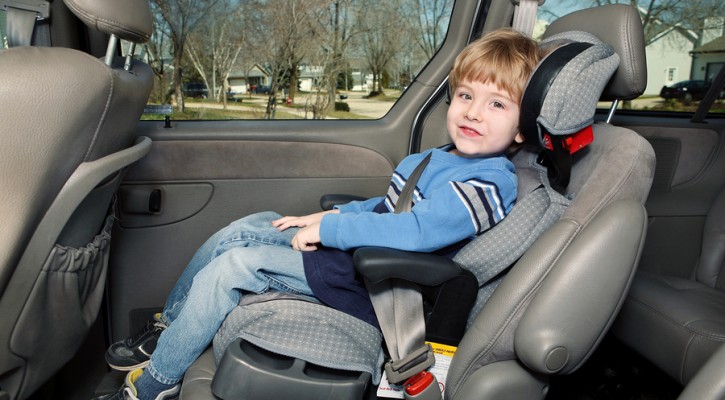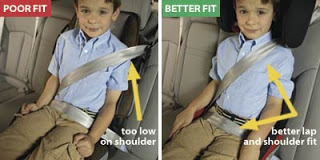Tag Archive: child safety seats

Kids In Cars Put In Danger By Parents
September 16, 2014
One in five parents put kids in cars in danger by “bending the rules” according to a survey conducted by Safe Kids Worldwide and funded by the General Motors Foundation. In the online survey, parents admitted that, when carpooling, they sometimes bent the rules by allowing kids to ride without a booster seat or even without seat belts.
According to Safe Kids, “Sixty-one percent of parents say they notice other carpool drivers bending the rules. Safe Kids research also shows that one in four parents report they don’t buckle up their children on every ride.”
Even on a short trip, the dangers of a crash are high. Most car crashes happen within 25 miles of home and at speeds under 45 mph. The reason for that is simple; your chances of being involved in a crash close to home are greater because that’s where you drive most often.
School age children should be belted into a booster seat seat until they are big enough to wear a seat belt properly. Safety experts say that kids should remain in a booster seat until they are at least 4’7” tall and weigh between 80 and 100 pounds. For most kids that’s between 9 and 11 years of age.
According to the National Highway Transportation Safety Administration (NHTSA), motor vehicle crashes were the leading cause of death for children age 4 and every age 11 through 14. They are the second leading cause of death for ages 5 through 10. NHTSA data shows that, “among passenger vehicle occupants 5 and older, seat belts saved an estimated 12,174 lives in 2012. If all passenger vehicle occupants 5 and older had worn seat belts, 15,205 lives (that is, an additional 3,031) could have been saved in 2012.”
Even on short trips, kids in cars need to be buckled into a child safety seat appropriate for their age. Parents who carpool should never take more children than the number of seat belts available in the vehicle. Carpooling parents should also arrange to swap out car seats and booster seats.
Don’t place yourself in the position of a parent who says “If only I had….”
For more information, read: STUDY REVEALS 9 OUT OF 10 PARENTS MOVE THEIR CHILD FROM BOOSTER SEAT TO SEAT BELT BEFORE THEIR CHILD IS BIG ENOUGH

Child Passenger Safety Week Sept. 14-20
September 15, 2014
This is National Child Passenger Safety Week and it’s a good time to remind parents or those who care for children, about the proper way to care for a child while driving. When it comes to child safety seats, one size doesn’t fit all and it’s important to understand how to choose and install the proper child seat according to your child’s age.
According to a survey by the National Highway Transportation Safety Administration (NHTSA), these are the most common mistakes made by parents when installing and using child safety seats and booster seats:
- Wrong harness slot used – The harness straps used to hold the child in the car seat were positioned either too low or too high;
- Harness chest clip positioned over the abdomen rather than the chest or not used at all;
- Loose car seat installation – The restraint system moved more than two inches side-to-side or front to back; anything more than one inch is too much.
- Loose harness – More than two inches of total slack between the child and the harness strap; there should be no slack.
- Seat belt placement was wrong – Lap belt resting over the stomach and/or shoulder belt on the child’s neck or face.
Both NHTSA and SafeKids recommend the following steps listed on the Safe Kids downloadable checklist:
- Right Seat. Check the label on your car seat to make sure it’s appropriate for your child’s age, weight and height.
- Right Place. Kids are VIPs, just ask them. We know all VIPs ride in the back seat, so keep all children in the back seat until they are 13. Doing this, along with correctly using the appropriate child restraints, greatly reduces the risk of injury.
- Right Direction. You want to keep your child in a rear-facing car seat for as long as possible. When he or she outgrows the seat, move your child to a forward-facing car seat. Make sure to attach the top tether after you tighten and lock the seat belt or lower anchors.
- Inch Test. Once your car seat is installed, give it a good shake at the base. Can you move it more than an inch side to side or front to back? A properly installed seat will not move more than an inch.
- Pinch Test. Make sure the harness is tightly buckled and coming from the correct slots (check manual). Now, with the chest clip placed at armpit level, pinch the strap at your child’s shoulder. If you are unable to pinch any excess webbing, you’re good to go.
Many parents don’t realize that child safety seats have an expiration date. The plastic and synthetic materials used to make the seat’s body and straps can break down over time when exposed to the high heat and sunshine in a parked car. It’s not a good idea to use a hand-me-down car seat for younger children.
There are several good websites that provide information on the proper selection, installation and care of child safety seats. For information about:
- Advice on child safety in and around cars, visit the Insurance Institute for Highway Safety (IIHS): http://www.iihs.org/iihs/brochures/keeping-children-safe
- IIHS ratings on booster seats, visit: http://www.iihs.org/iihs/ratings/child-boosters
- Where to find a car safety seat inspection station near you, visit: http://www.seatcheck.org/
- Child safety seat laws in your state: http://www.iihs.org/iihs/topics/laws/safetybeltuse?topicName=child-safety

Child Safety Seats Have An Expiration Date
October 14, 2011
In these hard economic times, when parents have a new child on the way, it is often tempting to use a hand-me-down child safety seat or a used child seat purchased from a second hand store but, did you know that child safety seats have expiration dates?
It is a little known fact that child safety seats have expiration dates; usually six years from the manufacture date. There is a very good reason for this. Child safety seats are made from synthetic, petroleum based plastics and fabrics. While these materials are excellent for this purpose and make for a very strong and reliable child protective seat, they are subjected to a lot of harmful environmental factors that can weaken them over the years.
Most child seats remain in the car and internal temperatures inside the car in the summer can easily reach 130 to 140 degrees and over time, this can lead to a breakdown of the plastic materials. Exposure to the sun is also harmful. Synthetic fabrics, especially nylon don’t tolerate long periods of direct exposure to the sun very well. When exposed to the sun over long periods, the synthetic fabrics can become brittle and break; not something you want a safety belt to do.
Read more about: Summer Heat Warnings – Never Leave Children Alone in Cars
So, while a used seat may look perfectly fine, there may be damage that is too small to see that can grow over time. Your little passenger is too precious to take that chance. Most seats have the expiration date embossed in the plastic on the bottom of the seat. When considering a used car seat, check the expiration date and make sure that your child will have outgrown it before it expires.
Parents should also remember that children who outgrow the child safety seat should graduate into a booster seat until they are at least 4’9” tall. Lots of kids are graduated to seat belts too early and their small frames prevent the seat belt from fitting properly low over their hips. If the belt should rise up over their abdomen, they could be injured in a crash.
For more information on child safety seats and booster seats, visit the Insurance Institute for Highway Safety at: http://www.iihs.org/research/topics/child_restraints/default.html
For help in learning how to properly install and use a child seat, the National Highway Traffic Safety Administration has a web site that can direct you to a trained Child Passenger Safety Technician in your area who can teach you how to install your seat, answer any questions you may have, and give you additional information on child safety seats. To locate a Child Passenger Safety Technician, visit: http://www.nhtsa.gov/cps/cpsfitting/index.cfm
Photo: Compliments Insurance Institute for Highway Safety
